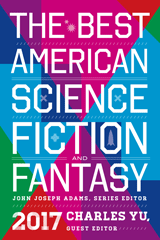The Best American Science Fiction and Fantasy 2017
- Edited by John Joseph Adams and Charles Yu
- Mariner Books
- 384 pp.
- Reviewed by Ariel S. Winter
- September 14, 2017
Twenty clever tales for fans of the fantastical.

The Best American Science Fiction and Fantasy 2017 is the third entry in Houghton Mifflin Harcourt’s most recent addition to their longstanding Best American series. The series editor, John Joseph Adams, selected 80 pieces of short fiction that appeared in North America last year, and celebrity guest editor Charles Yu winnowed that number down to 20.
Yu, who rose to prominence with his lauded novel, How to Live Safely in a Science Fictional Universe, brings his playfulness and penchant for the metafictional to the volume, on display in his excellent introduction.
Cast as a series of dialogues between Yu and interdimensional travelers at his local coffeeshop, Yu addresses the current political crisis, saying that “America in 2017 isn’t one reality. It’s two separate ones, mostly distinct but with some overlap.”
He suggests that science fiction and fantasy, genres unique in imagining other realities, offer hope, because they are proof that “at least a few people [are] interested in imagining better worlds, other worlds, the existence of alternative points of view.”
It’s a strong argument for the importance of genre fiction as both a salve and a step toward a solution for a world in which reality has become a subjective term. That might be too heady a claim to lay upon any one book, but regardless of how well the various stories in this anthology reach that height — or even attempt it — the sentiment feels true.
Anthologies often suffer from variable quality, forcing a reader to wade through a lot of mediocrity to reach the gems. Adams and Yu have managed to avoid that pitfall. All of the stories in the 2017 Best American Science Fiction and Fantasy are good, and many are brilliant.
The best of them have a layer of social commentary. That’s not an essential component of fiction by any means — the editors haven’t lost sight of the fact that fun should still be an essential element, and these stories are fun. But the stories with direct social commentaries end up being the most satisfying. Adams’ foreword invokes the television show “Black Mirror,” and the comparison is apt. Both present stories that reflect back on our world by showing us an alternate world with a strange twist.
In “When They Came to Us,” a story that reads like "Invasion of the Body Snatchers" crossed with "Mrs. Bridge," Debbie Urbanski shows the effects on a suburban town when the government relocates aliens there. The “blues” are reluctantly tolerated, but not accepted, and ultimately resented and hated in a way that echoes the anti-immigrant and anti-refugee rhetoric prevalent in our own America.
In “Openness,” Alexander Weinstein imagines a world in which Facebook profiles are on psychic display at all times, allowing everyone on the street some entry into each other’s personal life. With that premise underlying a simple love story, Weinstein reveals how taking the wanton openness of social media to that extreme can destroy human relationships.
In “Not a Wardrobe, Tornado, or Looking Glass,” a portal story in the Narnia, Oz, and Wonderland tradition, a young temp watches everyone in the world disappear through a private portal, abandoning everything for the comfort of his or her fantasy world. Meant as a commentary on what makes the world fantastic to each individual, the way in which all these people escape life is unintentionally reminiscent of the way the current opioid epidemic has ravaged some communities, slowly taking over almost everyone while people on the outside watch helplessly.
Other stories address Black Lives Matter (Joseph Allen Hill’s metafictional “The Venus Effect”); the media (“Caspar D. Luckinbill, What Are You Going to Do?” by Nick Wolven); and the inanity of the medical system (“Welcome to the Medical Clinic at the Interplanetary Relay Station/Hours Since the Last Patient Death: 0” by Caroline M. Yoachim). But even the stories that don’t directly tackle such grave topics still achieve the goal of great fiction: to explore and expose the human.
Yu received Adams’ selection with no bylines, and it’s heartening to see that out of 20 stories, his blind reading resulted in choosing 10 that were written by women, one by a “queer nonbinary writer,” and five by people of color.
At the end of the book, each author provides a contributor’s note, a short behind-the-scenes snapshot similar to the special features on a DVD. In his note, Wolven writes about the “natural affinity between science fiction and satire, since both depend in some sense on the art of exaggeration…science fiction sets out to make the strange seem ordinary — or anyway, plausible — while good satire often succeeds at making the ordinary seem strange.”
The best of the Best American Science Fiction and Fantasy 2017 definitely achieves that goal. But all of the stories are worth reading, for the pleasure and the humor, if not for Yu’s lofty “hope.”
Ariel S. Winter was a finalist for the Los Angeles Times Book Prize, the Shamus Award, and the Macavity Award for his novel The Twenty-Year Death. He is also the author of the novel Barren Cove and the children’s picture book One of a Kind, illustrated by David Hitch. He lives in Baltimore.

